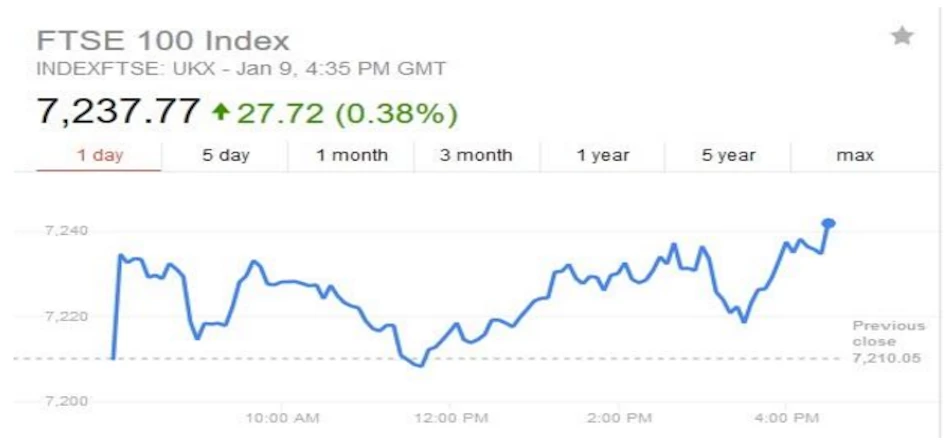
Partner Article
GBP Stares Down the Barrel While FTSE Soars
The FTSE 100 index is riding a wave of bullish sentiment. The recent performance of the all share index has outperformed expectations, posting its best winning streak in 33 years. The GBP has hit a multi-month low, after Prime Minister Theresa May announced that Britain would be seeking a Brexit as soon as possible. The ongoing weakness of the GBP is helping to drive up the FTSE 100 index.
The inverse relationship between the FTSE 100 and the GBP is a direct result of foreign companies comprising the bulk of the earning potential in the FTSE 100 index. When euros, yen and dollars are converted into sterling the sterling value appreciates. This paints a skewed picture of the performance of the FTSE 100 index.
During the day on Monday, 9 January 2017, the FTSE 100 index touched 7,243.76 before retreating. Tremendous levels of currency trading activity were noted in the City of London, with call options on the USD and put options on the GBP/USD pair. The DXY (US Dollar Index) is hovering around 14-year highs and this driving down the cable. The dollar’s run on the sterling was assisted by speculators who fear a hard Brexit. The FTSE 100 index closed at a record level for the eighth day on the trot, besting records last seen in 1997.
The recent performance of the FTSE 100 index is unlike anything we have seen in recent history. The latest Bull Run began towards the end of December at the height of the Christmas shopping season with trading reaching a crescendo. The rally has continued into 2017, fueled in strong part by weakness in the GBP.
The performance of the FTSE 100 index is in stark contrast to the performance of indices across Europe. The inverse relationship between Britain’s premier index and its currency is well-known. The FTSE 100 has been posting strong gains ever since the June 23 Brexit referendum, and momentum has never let up.
Is a Hard Brexit In-Store for the United Kingdom?
The 28-point gain on Monday, 9 January allowed the index to reach a new record. Of course, the 1% slide against the greenback and the 2% slide against the euro are fueling the latest rally on the London Stock Exchange (LSE). The foreign earnings generated by companies listed on the FTSE 100 index are worth more when converted into GBP as the sterling depreciates.
However, it was Britain’s Prime Minister who kick started the fresh new rally by promising to take control of immigration and of the country’s rule of law. Prime Minister May ruled out the prospect of bits and pieces membership of the European Union, and presented the prospect of a hard Brexit.
For her part, the Prime Minister rejects the notion of a soft Brexit or a hard Brexit. She also held firm on her position to lead the UK out of the EU. To do so, Article 50 of the Lisbon Treaty must be invoked. Once that is done, Britain will have 2 years to get things in order before its membership of the EU is effectively terminated.
Brexit uncertainty remains the most pressing concern for the UK economy. However, it is not all doom and gloom for Britain. Consumer stocks and basic resources are performing well. The top gainers in the all share index included BHP Billiton, Randgold Resources and the biggest gainer, Glencore up +3.6%. Mining stocks have been propelling the FTSE 100 index in recent days, with strong support from the energy sector too.
This was posted in Bdaily's Members' News section by Boris Dzhingarov .
Enjoy the read? Get Bdaily delivered.
Sign up to receive our popular morning National email for free.








 How to make your growth strategy deliver in 2026
How to make your growth strategy deliver in 2026
 Powering a new wave of regional screen indies
Powering a new wave of regional screen indies
 A new year and a new outlook for property scene
A new year and a new outlook for property scene
 Zero per cent - but maximum brand exposure
Zero per cent - but maximum brand exposure
 We don’t talk about money stress enough
We don’t talk about money stress enough
 A year of resilience, growth and collaboration
A year of resilience, growth and collaboration
 Apprenticeships: Lower standards risk safety
Apprenticeships: Lower standards risk safety
 Keeping it reel: Creating video in an authenticity era
Keeping it reel: Creating video in an authenticity era
 Budget: Creating a more vibrant market economy
Budget: Creating a more vibrant market economy
 Celebrating excellence and community support
Celebrating excellence and community support
 The value of nurturing homegrown innovation
The value of nurturing homegrown innovation
 A dynamic, fair and innovative economy
A dynamic, fair and innovative economy